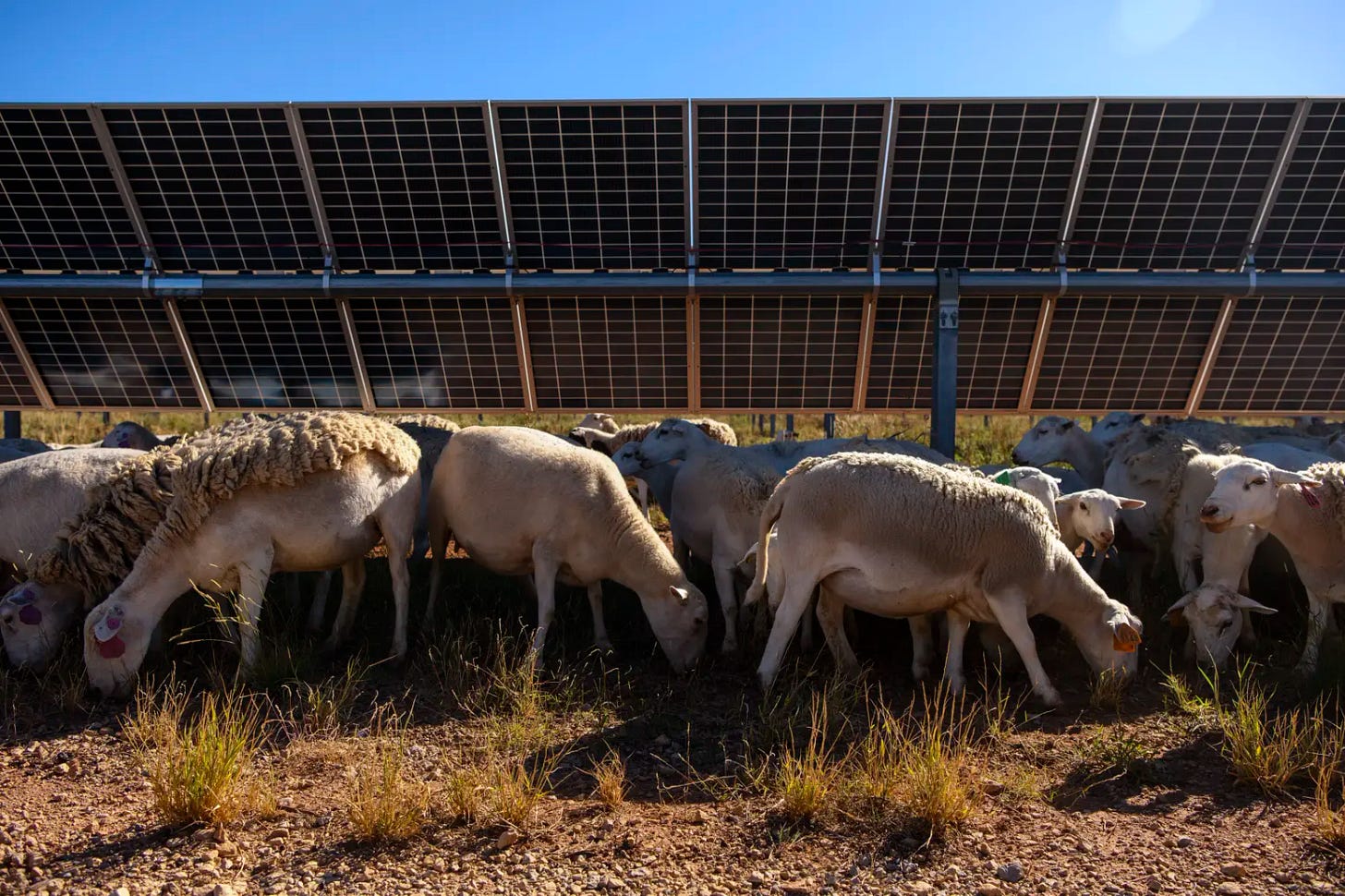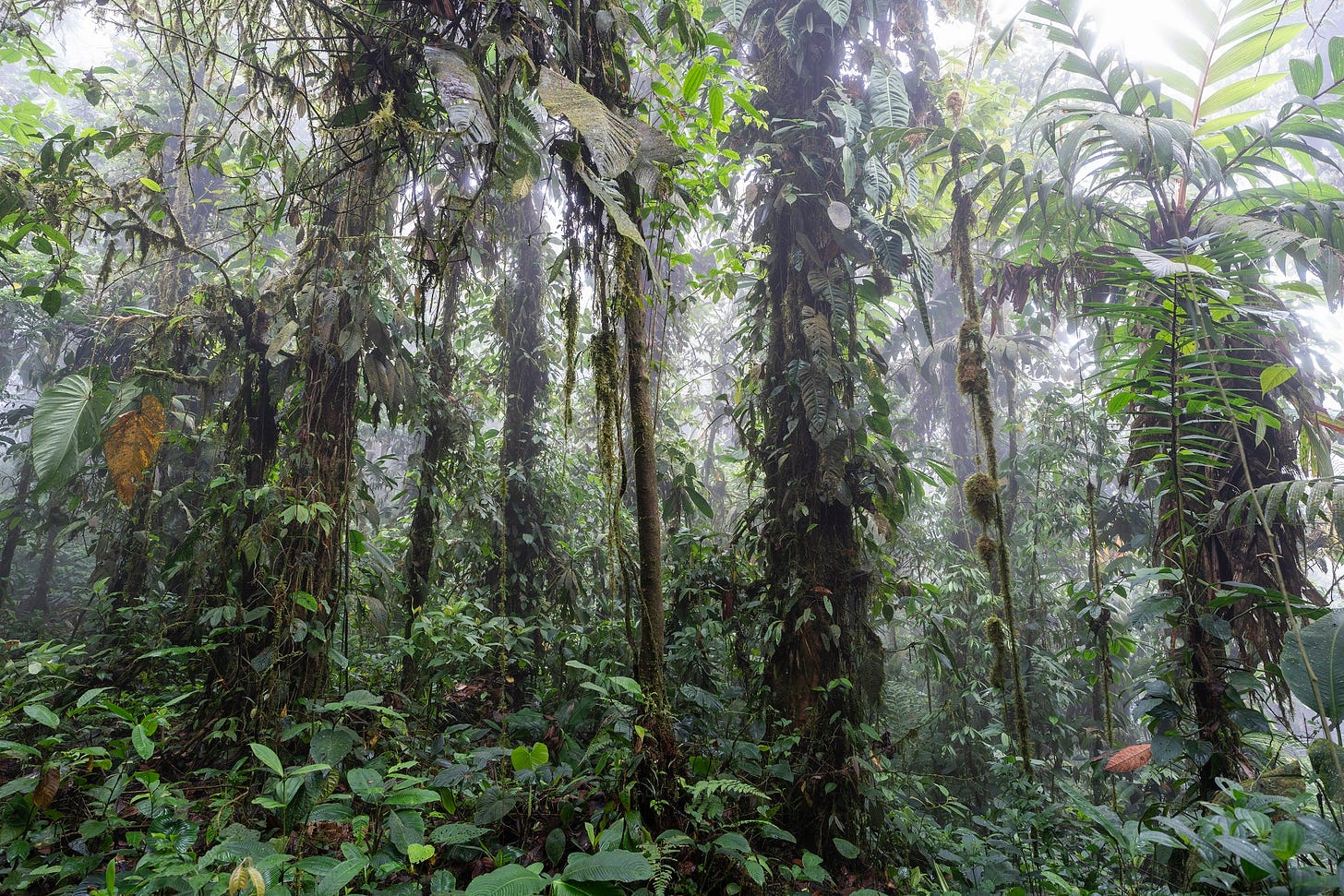The Weekly Anthropocene, November 1 2023
Epic progress on the global renewables revolution, a "Yellowstone for Europe" in Romania, a titanium and carbon fiber airship, short corn, offshore wind, the UAW, HALEU, AI for wildlife, and more!
The Big Picture: Renewables Are Unstoppable!

The International Energy Agency recently released their blockbuster World Energy Outlook 2023 report1 (here’s the executive summary), and it contains some incredible news on the rapidly advancing global renewables revolution. The world has other things on its collective mind right now, but this is really worth taking a moment to pay attention to, celebrate, and be inspired by!
Here are some key takeaways and IEA quotes:
Global greenhouse gas emissions are expected to peak before 2025, possibly as soon as this year (2023) and decline thereafter!
Every year, rapidly advancing renewables deployment and national policy actions are adjusting projected future global greenhouse gas emissions in the right direction (see chart above)!
“Renewables are set to contribute 80% of new power capacity to 2030 in the STEPS [stated policy scenario, the path we’re currently on], with solar PV alone accounting for more than half.”
“In 2020, one in 25 cars sold was electric; in 2023, this is now one in 5.”
Under current policies, global fossil fuel use is expected to peak by 2025, and global coal, oil, and gas use are each individually expected to peak before 2030.
“Thanks largely to the Inflation Reduction Act in the United States, we now project that 50% of new US car registrations will be electric in 2030 in the STEPS.”
Fossil fuel use is expected to peak by 2024 in rapidly-decarbonizing China.
Global investment in clean energy in 2023 is at about 1.8 trillion USD per year, compared to just 1 trillion for fossil fuels. The IEA expects global clean energy investment to be 2.5 times larger than global fossil fuel investment by 2030.
“More than 500 gigawatts (GW) of renewables generation capacity are set to be added in 2023 – a new record.”
“Sales of cars and two/three-wheel vehicles with internal combustion engines are well below where they were before the Covid-19 pandemic. In the electricity sector, worldwide additions of coal- and natural gas-fired power plants have halved, at least, from earlier peaks. Sales of residential gas boilers have been trending downwards and are now outnumbered by sales of heat pumps in many countries in Europe and in the United States.”
“More than USD 1 billion a day is being spent on solar deployment.”
“Bending the emissions curve onto a path consistent with 1.5 °C remains possible but very difficult…despite the impressive clean energy growth based on today’s policy settings, global emissions would remain high enough to push up global average temperatures by around 2.4°C this century.”
Even as climate change’s impacts ramp up, human civilization is at long last winning the fight to transition to a decarbonized energy system, and this writer would bet on it continuing to accelerate even faster than the IEA expects. It’s taken much longer than it should have, but we’re starting to really hit our stride!
“The transition to clean energy is happening worldwide and it’s unstoppable. It’s not a question of ‘if’, it’s just a matter of ‘how soon’ – and the sooner the better for all of us.
Governments, companies and investors need to get behind clean energy transitions rather than hindering them. There are immense benefits on offer, including new industrial opportunities and jobs, greater energy security, cleaner air, universal energy access and a safer climate for everyone. Taking into account the ongoing strains and volatility in traditional energy markets today, claims that oil and gas represent safe or secure choices for the world’s energy and climate future look weaker than ever.”
-International Energy Agency Executive Director Fatih Birol.
New Protected Areas



In Romania, the Foundation Conservation Carpathia is buying land with the goal of creating a 200,000-hectare wilderness reserve, a “Yellowstone for Europe” in the Carpathian Mountains2. They’ve already bought 26,900 hectares, planted over 4 million saplings, and reintroduced European bison.
New Caledonia, a French territory in the Pacific, announced that it would expand higher protections to cover a full 10% of its oceanic exclusive economic zone (up from just 2.4%), protecting whale, turtle, seabird, and coral reef habitat from fishing and drilling.
Scotland has pledged to create at least one new national park by 2026, and several different regions have submitted bids. Relatedly, the 19 wildcats released into the existing Cairngorms National Park in summer 2023 are thriving.
New Technologies

Google founder Sergey Brin has received federal clearance to begin outdoor flight testing of his experimental titanium and carbon fiber airship, the Pathfinder 1. At 124 meters long, substantially longer than a jumbo jet, this behemoth is now the largest lighter-than-air airship anywhere in the world since the infamous crashing of the Hindenburg in 1937. (Unlike the Hindenburg, the Pathfinder 1 uses non-flammable helium as its lifting gas instead of hydrogen). A 180-meter Pathfinder 3 is already being built in Ohio, and Brin’s company, LTA Research, plans to develop more airships for use in disaster relief and cargo transport. As Bill McKibben recently wrote, in a decarbonized future, there might be blimps!
This newsletter recently wrote about eVTOLs (electric flying taxis, essentially) as an emerging clean transport technology, with several American companies nearing the commercial stage. Now, China has given regulatory approval to a pilotless eVTOL model that should start commercial flights over Guangdong by the end of the year. Electric flying cars, folks!
Labs around the world are starting to find new ways to use advanced chemistry at extreme temperatures and pressures to finally break down PFAS, the widely used per-and polyfluoroalkyl substances known for possible health risks. “Forever chemicals” no more, hopefully!
Short corn is an emerging climate resilience solution. It’s as simple as it sounds: breeding or genetically engineering corn plants to grow ears of corn on shorter cornstalks, with the same or higher yield but less risk of being blown over in extreme weather. This is not a hypothetical concern: an extreme windstorm in August 2020 destroyed about 16% of Iowa’s corn and soybean crop. These kind of agricultural innovations will help safeguard humanity’s food supply despite climate disruption!
Innovative new uses of AI in wildlife conservation are popping up around the world.
In Ecuador, AI tools analyzing and identifying species heard in acoustic monitoring data (formerly a human expert-level task) was found to correlate with recovering forests’ overall biodiversity level. We’re successfully automating measuring the health of a forest from its soundscape.
A global research initiative is using AI to analyze remote sensing data and predict likely hotspots for underground mycorrhizal fungi networks.
And in Nepal, researchers are working to use AI and camera traps to recognize and profile individual spotted deer based on their spot patterns.
United States

States across America are continuing to move forward on climate action and the renewables revolution!
The state of New York awarded contracts for three massive new offshore wind projects, totaling more than 4 gigawatts (4,000 MW) of generation capacity.
The United Auto Workers union has reached deals with General Motors, Ford, and Stellantis (formerly Chrysler), the “Big Three” Detroit automakers, that will ensure higher wages for workers manufacturing electric vehicles in America.
Colorado passed a mandate requiring EVs to make up 82% of dealer sales by 2032, up from 17% (in Colorado) in Q3 2023.
The federal Bureau of Ocean Energy Management designated a large swathe of the Gulf of Maine as suitable for offshore wind development, carefully avoiding areas used by the Maine lobster industry, key ground fish habitat, and North Atlantic right whale restricted zones.
The Department of Energy announced $1.3 billion in Bipartisan Infrastructure Law loans to help speed three vital gigawatt-scale transmission line projects, which will create new grid links from Utah to Nevada, New Mexico to Arizona, and Quebec to Vermont and New Hampshire.
Xcel Energy, a leading utility, announced a request for proposals (i.e. seeking to buy) for 1.2 gigawatts (1,200 MW) worth of wind power in southwest Minnesota to help replace the Sherco coal plant it plans to retire by 2030. Xcel plans to use the old coal plant’s transmission line connections to skip the grid backlog and help bring more renewables online fast!
Xcel also recently announced that they would shut down their 1,067-MW Tolk coal plant in New Mexico by 2028, and limit its operations until then.
A newly opened plant in Ohio now provides the only domestically produced high-assay, low-enriched uranium (HALEU) in America. (The U.S. HALEU field has been boosted by funding from the trusty Inflation Reduction Act!). As The Weekly Anthropocene has previously discussed, HALEU was only produced in Russia until now, a major stumbling block for next-generation nuclear reactor designs. American-made HALEU could help make small-scale nuclear a working proposition to help complement the renewables revolution.
Note that this is similar to but not the same as the last big IEA report we wrote about recently; it’s another report from the same organization.
Basically the same model as the great American Prairie Reserve in Montana!






This is just awesome. Really refreshing to see and extra motivation to keep pushing!!
A Yellowstone in Europe, that I would like to see! Thank, Sam, for brightening my day with some great news.